Effect of Bias Voltage on Mechanical Properties of HiPIMS/RFMS Cosputtered Zr–Si–N Films
Abstract
:1. Introduction
2. Materials and Methods
3. Results and Discussion
3.1. Chemical Compositions and Phases
3.2. Mechanical Properties
4. Conclusions
Author Contributions
Funding
Acknowledgments
Conflicts of Interest
References
- Mae, T.; Nose, M.; Zhou, M.; Nagae, T.; Shimamura, K. The effects of Si addition on the structure and mechanical properties of ZrN thin films deposited by an r.f. reactive sputtering method. Surf. Coat. Technol. 2001, 142–144, 954–958. [Google Scholar] [CrossRef]
- Martin, P.J.; Bendavid, A.; Cairney, J.M.; Hoffman, M. Nanocomposite Ti–Si–N, Zr–Si–N, Ti–Al–Si–N, Ti–Al–V–Si–N thin film coatings deposited by vacuum arc deposition. Surf. Coat. Technol. 2005, 200, 2228–2235. [Google Scholar] [CrossRef]
- Dong, Y.; Zhao, W.; Li, Y.; Li, G. Influence of silicon on the microstructure and mechanical properties of Zr–Si–N composite films. Appl. Surf. Sci. 2006, 252, 5057–5062. [Google Scholar] [CrossRef]
- Choi, H.; Jang, J.; Zhang, T.; Kim, J.H.; Park, I.W.; Kim, K.H. Effect of Si addition on the microstructure, mechanical properties and tribological properties of Zr–Si–N nanocomposite coatings deposited by a hybrid coating system. Surf. Coat. Technol. 2014, 259, 707–713. [Google Scholar] [CrossRef]
- Chen, Y.I.; Chang, S.C.; Chang, L.C. Oxidation resistance and mechanical properties of Zr–Si–N coatings with cyclic gradient concentration. Surf. Coat. Technol. 2017, 320, 168–173. [Google Scholar] [CrossRef]
- Chang, L.C.; Zheng, Y.Z.; Chen, Y.I.; Chang, S.C.; Liu, B.L. Bonding characteristics and chemical inertness of Zr–Si–N coatings with a high Si content in glass molding. Coatings 2018, 8, 181. [Google Scholar] [CrossRef]
- Veprek, S.; Niederhofer, A.; Moto, K.; Bolom, T.; Männling, H.-D.; Nesladek, P.; Dollinger, G.; Bergmaier, A. Composition, nanostructure and origin of the ultrahardness in nc-TiN/a-Si3N4/a- and nc-TiSi2 nanocomposites with HV = 80 to ≥ 105 GPa. Surf. Coat. Technol. 2000, 133–134, 152–159. [Google Scholar] [CrossRef]
- Diserens, M.; Patscheider, J.; Lévy, F. Mechanical properties and oxidation resistance of nanocomposite TiN–SiNx physical-vapor-deposited thin films. Surf. Coat. Technol. 1999, 120–121, 158–165. [Google Scholar] [CrossRef]
- Benkahoul, M.; Sandu, C.S.; Tabet, N.; Parlinska-Wojtan, M.; Karimi, A.; Lévy, F. Effect of Si incorporation on the properties of niobium nitride films deposited by DC reactive magnetron sputtering. Surf. Coat. Technol. 2004, 188–189, 435–439. [Google Scholar] [CrossRef]
- Sandu, C.S.; Benkahoul, M.; Sanjinés, R.; Lévy, F. Model for the evolution of Nb–Si–N thin films as a function of Si content relating the nanostructure to electrical and mechanical properties. Surf. Coat. Technol. 2006, 201, 2897–2903. [Google Scholar] [CrossRef]
- Sandu, C.S.; Sanjinés, R.; Benkahoul, M.; Medjani, F.; Lévy, F. Formation of composite ternary nitride thin films by magnetron sputtering co-deposition. Surf. Coat. Technol. 2006, 201, 4083–4089. [Google Scholar] [CrossRef]
- Kouznetsov, V.; Macák, K.; Schneider, J.M.; Helmersson, U.; Petrov, I. A novel pulsed magnetron sputter technique utilizing very high target power densities. Surf. Coat. Technol. 1990, 122, 290–293. [Google Scholar] [CrossRef]
- Helmersson, U.; Lattemann, M.; Bohlmark, J.; Ehiasarian, A.P.; Gudmundsson, J.T. Ionized physical vapor deposition (IPVD): A review of technology and applications. Thin Solid Films 2006, 513, 1–24. [Google Scholar] [CrossRef] [Green Version]
- Gudmundsson, J.T.; Brenning, N.; Lundin, D.; Helmersson, U. High power impulse magnetron sputtering discharge. J. Vac. Sci. Technol. A 2012, 30, 030801. [Google Scholar] [CrossRef] [Green Version]
- Purandare, Y.P.; Ehiasarian, A.P.; Hovsepian, P.E. Structure and properties of ZrN coatings deposited by high power impulse magnetron sputtering technology. J. Vac. Sci. Technol. A 2011, 29, 011004. [Google Scholar] [CrossRef] [Green Version]
- Ehiasarian, A.P.; Münz, W.-D.; Hultman, L.; Helmersson, U.; Petrov, I. High power pulsed magnetron sputtered CrNx films. Surf. Coat. Technol. 2003, 163–164, 267–272. [Google Scholar] [CrossRef]
- Greczynski, G.; Lu, J.; Jensen, J.; Bolz, S.; Kölker, W.; Schiffers, C.; Lemmer, O.; Greene, J.E.; Hultman, L. A review of metal-ion-flux-controlled growth of metastable TiAlN by HIPIMS/DCMS co-sputtering. Surf. Coat. Technol. 2014, 257, 15–25. [Google Scholar] [CrossRef] [Green Version]
- Chang, L.C.; Chang, C.Y.; You, Y.W. Ta–Zr–N thin films fabricated through HIPIMS/RFMS co-sputtering. Coatings 2017, 7, 189. [Google Scholar] [CrossRef]
- Chang, L.C.; Zheng, Y.Z.; Chen, Y.I. Mechanical properties of Zr–Si–N films fabricated through HiPIMS/RFMS co-sputtering. Coatings 2018, 8, 263. [Google Scholar] [CrossRef]
- Tang, Q.L.; Wu, Y.C.; Lou, B.S.; Chen, Z.Y.; Lee, J.W. Mechanical property evaluation of ZrSiN films deposited by a hybrid superimposed high power impulse- medium frequency sputtering and RF sputtering system. Surf. Coat. Technol. 2019. [Google Scholar] [CrossRef]
- Sundgren, J.-E.; Johansson, B.-O.; Hentzell, H.T.G.; Karlsson, S.-E. Mechanisms of reactive sputtering of titanium nitride and titanium carbide III: Influence of substrate bias on composition and structure. Thin Solid Films 1983, 105, 385–393. [Google Scholar] [CrossRef]
- Petrov, I.; Hultman, L.; Helmersson, U.; Sundgren, J.-E.; Greene, J.E. Microstructure modification of TiN by ion bombardment during reactive sputter deposition. Thin Solid Films 1989, 169, 299–314. [Google Scholar] [CrossRef]
- Lee, H.C.; Lee, J.Y.; Ahn, H.J. Effect of the substrate bias voltage on the crystallographic orientation of reactively sputtered AlN thin films. Thin Solid Films 1994, 251, 136–140. [Google Scholar] [CrossRef]
- Wang, H.; Zhang, S.; Li, Y.; Sun, D. Bias effect on microstructure and mechanical properties of magnetron sputtered nanocrystalline titanium carbide thin films. Thin Solid Films 2008, 516, 5419–5423. [Google Scholar] [CrossRef]
- Vaz, F.; Rebouta, L.; Goudeau, P.; Girardeau, T.; Pacaud, J.; Riviére, J.P.; Traverse, A. Structural transitions in hard Si-based TiN coatings: The effect of bias voltage and temperature. Surf. Coat. Technol. 2001, 146–147, 274–279. [Google Scholar] [CrossRef]
- Yang, Z.T.; Yang, B.; Guo, L.P.; Fu, D.J. Effect of bias voltage on the structure and hardness of Ti–Si–N composite coatings synthesized by cathodic arc assisted middle-frequency magnetron sputtering. J. Alloy. Compd. 2009, 473, 437–441. [Google Scholar] [CrossRef]
- Oliver, W.C.; Pharr, G.M. An improved technique for determining hardness and elastic modulus using load and displacement sensing indentation experiments. J. Mater. Res. 1992, 7, 1564–1583. [Google Scholar] [CrossRef]
- Musil, J.; Kunc, F.; Zeman, H.; Poláková, H. Relationships between hardness, Young’s modulus and elastic recovery in hard nanocomposite coatings. Surf. Coat. Technol. 2002, 154, 304–313. [Google Scholar] [CrossRef]
- Janssen, G.C.A.M.; Abdalla, M.M.; van Keulen, F.; Pujada, B.R.; van Venrooy, B. Celebrating the 100th anniversary of the Stoney equation for film stress: Developments from polycrystalline steel strips to single crystal silicon wafers. Thin Solid Films 2009, 517, 1858–1867. [Google Scholar] [CrossRef]
- Barin, I. Thermochemical Data of Pure Substances, 3rd ed.; VCH: New York, NY, USA, 1995. [Google Scholar]
- Sandu, C.S.; Cusnir, N.; Oezer, D.; Sanjinés, R.; Patscheider, J. Influence of bias voltage on the microstructure and physical properties of magnetron sputtered Zr–Si–N nanocomposite thin films. Surf. Coat. Technol. 2009, 204, 969–972. [Google Scholar] [CrossRef]
- Lee, J.W.; Tien, S.K.; Kuo, Y.C. The effects of pulse frequency and substrate bias to the mechanical properties of CrN coatings deposited by pulsed DC magnetron sputtering. Thin Solid Films 2006, 494, 161–167. [Google Scholar] [CrossRef]
- Wang, Z.; Zhang, D.; Ke, P.; Liu, X.; Wang, A. Influence of substrate negative bias on structure and properties of TiN coatings prepared by hybrid HIPIMS method. J. Mater. Sci. Technol. 2015, 31, 37–42. [Google Scholar] [CrossRef]
- Chang, L.C.; Chang, C.Y.; Chen, Y.I.; Kao, H.L. Mechanical properties and oxidation behavior of ZrNx thin films fabricated through high-power impulse magnetron sputtering deposition. J. Vac. Sci. Technol. A 2016, 34, 02D107. [Google Scholar] [CrossRef]
- Qi, Z.B.; Sun, P.; Zhu, F.P.; Wang, Z.C.; Peng, D.L.; Wu, C.H. The inverse Hall–Petch effect in nanocrystalline ZrN coatings. Surf. Coat. Technol. 2011, 205, 3692–3697. [Google Scholar] [CrossRef]
- Leyland, A.; Matthews, A. On the significance of the H/E ratio in wear control: A nanocomposite coating approach to optimised tribological behavior. Wear 2000, 246, 1–11. [Google Scholar] [CrossRef]
- Liu, K.Y.; Lee, J.W.; Wu, F.B. Fabrication and tribological behavior of sputtering TaN coatings. Surf. Coat. Technol. 2014, 259, 123–128. [Google Scholar] [CrossRef]
- Pogrebnjak, A.D.; Beresnev, V.M.; Bondar, O.V.; Postolnyi, B.O.; Zaleski, K.; Coy, E.; Jurga, S.; Lisovenko, M.O.; Konarski, P.; Rebouta, L.; et al. Superhard CrN/MoN coatings with multilayer architecture. Mater. Des. 2018, 153, 47–59. [Google Scholar] [CrossRef]
- Musil, J. Hard nanocomposite coatings: Thermal stability, oxidation resistance and toughness. Surf. Coat. Technol. 2012, 207, 50–65. [Google Scholar] [CrossRef]
- Tsui, T.Y.; Pharr, G.M.; Oliver, W.C.; Bhatia, C.S.; White, R.L.; Anders, S.; Anders, A.; Brown, I.G. Nanoindentation and nanoscratching of hard carbon coatings for magnetic disks. Mater. Res. Soc. Symp. Proc. 1995, 383, 447–452. [Google Scholar] [CrossRef]
- Liu, C.Y.; Diyatmika, W.; Lou, B.S.; Lu, Y.C.; Duh, J.G.; Lee, J.W. Influences of target poisoning on the mechanical properties of TiCrBN thin films grown by a superimposed high power impulse and medium-frequency magnetron sputtering. Surf. Coat. Technol. 2017, 332, 86–95. [Google Scholar] [CrossRef]
- Silva Neto, P.C.; Freitas, F.G.R.; Fernandez, D.A.R.; Carvalho, R.G.; Felix, L.C.; Terto, A.R.; Hubler, R.; Mendes, F.M.T.; Silva Junior, A.H.; Tentardini, E.K. Investigation of microstructure and properties of magnetron sputtered Zr-Si-N thin films with different Si content. Surf. Coat. Technol. 2018, 353, 355–363. [Google Scholar] [CrossRef]
- Musil, J.; Daniel, R.; Zeman, P.; Takai, O. Structure and properties of magnetron sputtered Zr–Si–N films with a high (≥ 25 at.%) Si content. Thin Solid Films 2005, 478, 238–247. [Google Scholar] [CrossRef]

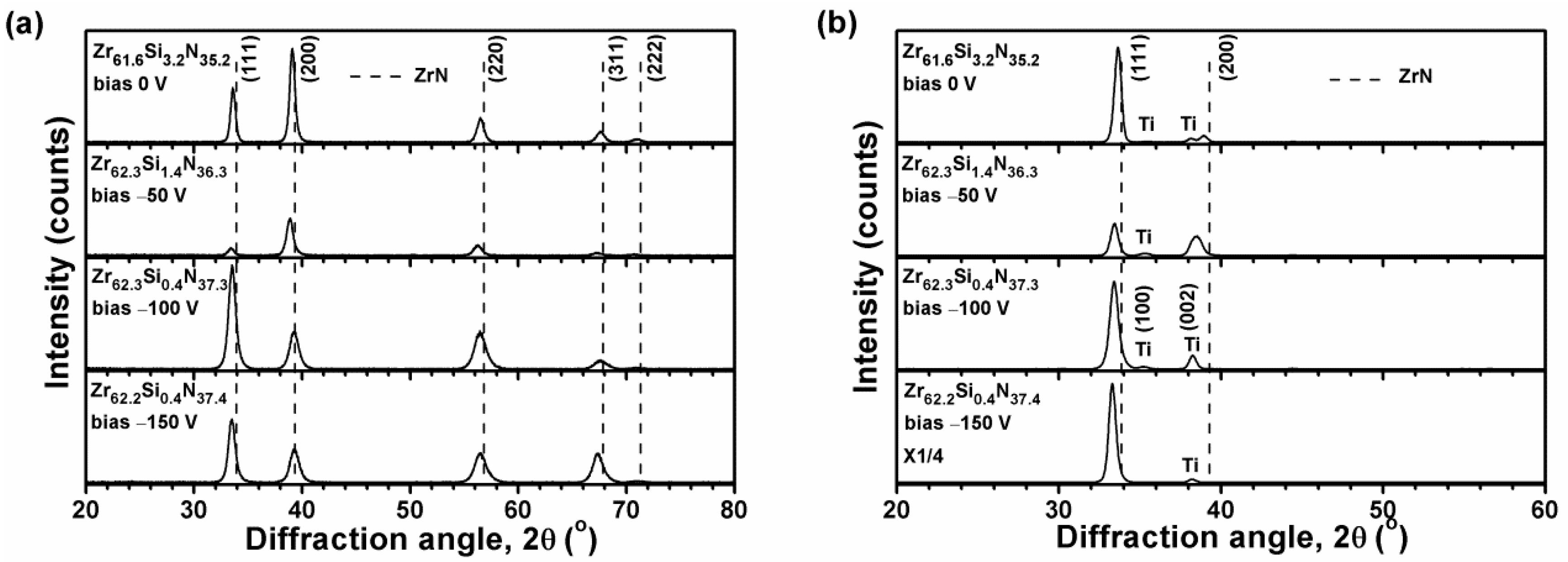


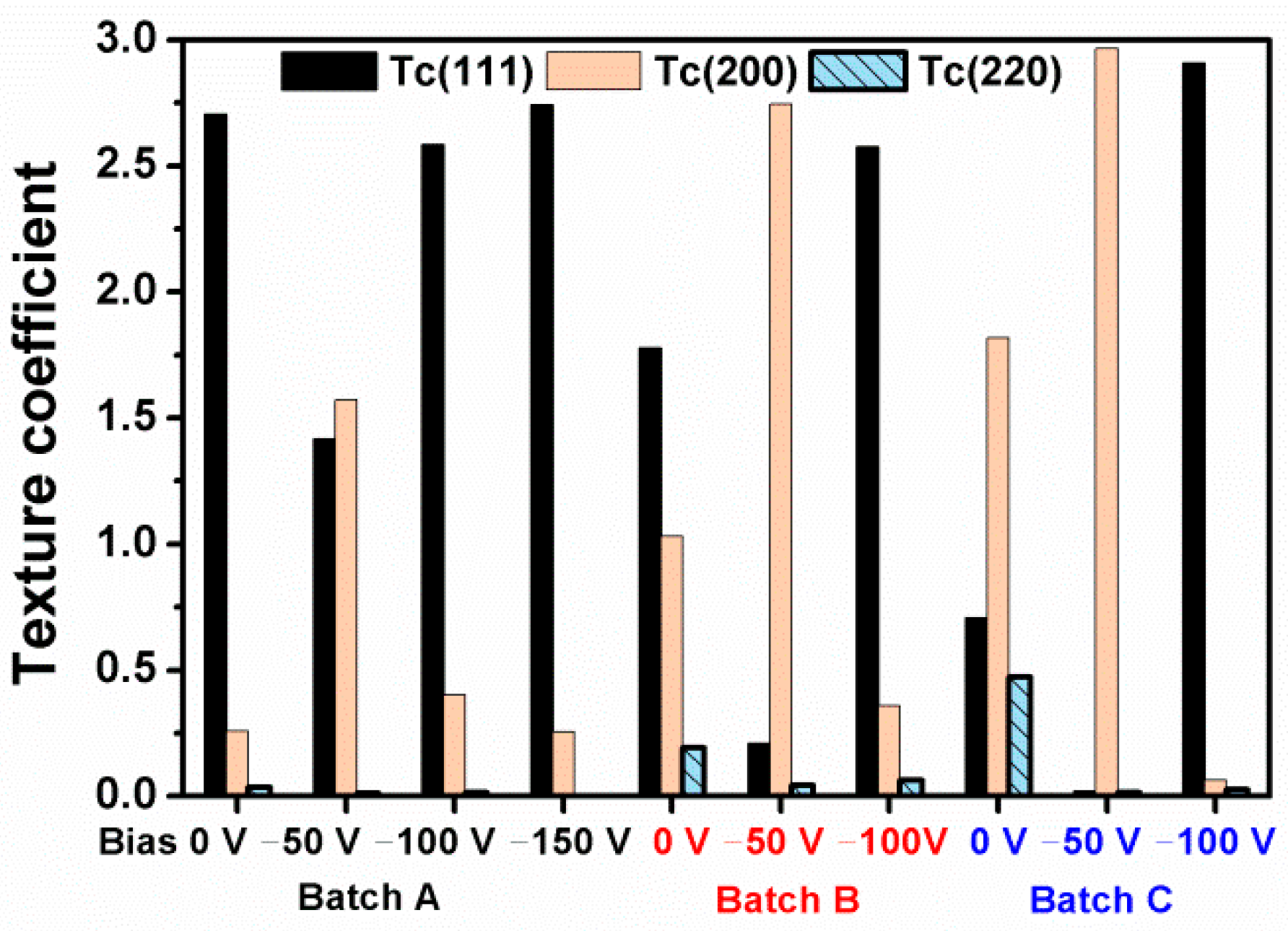
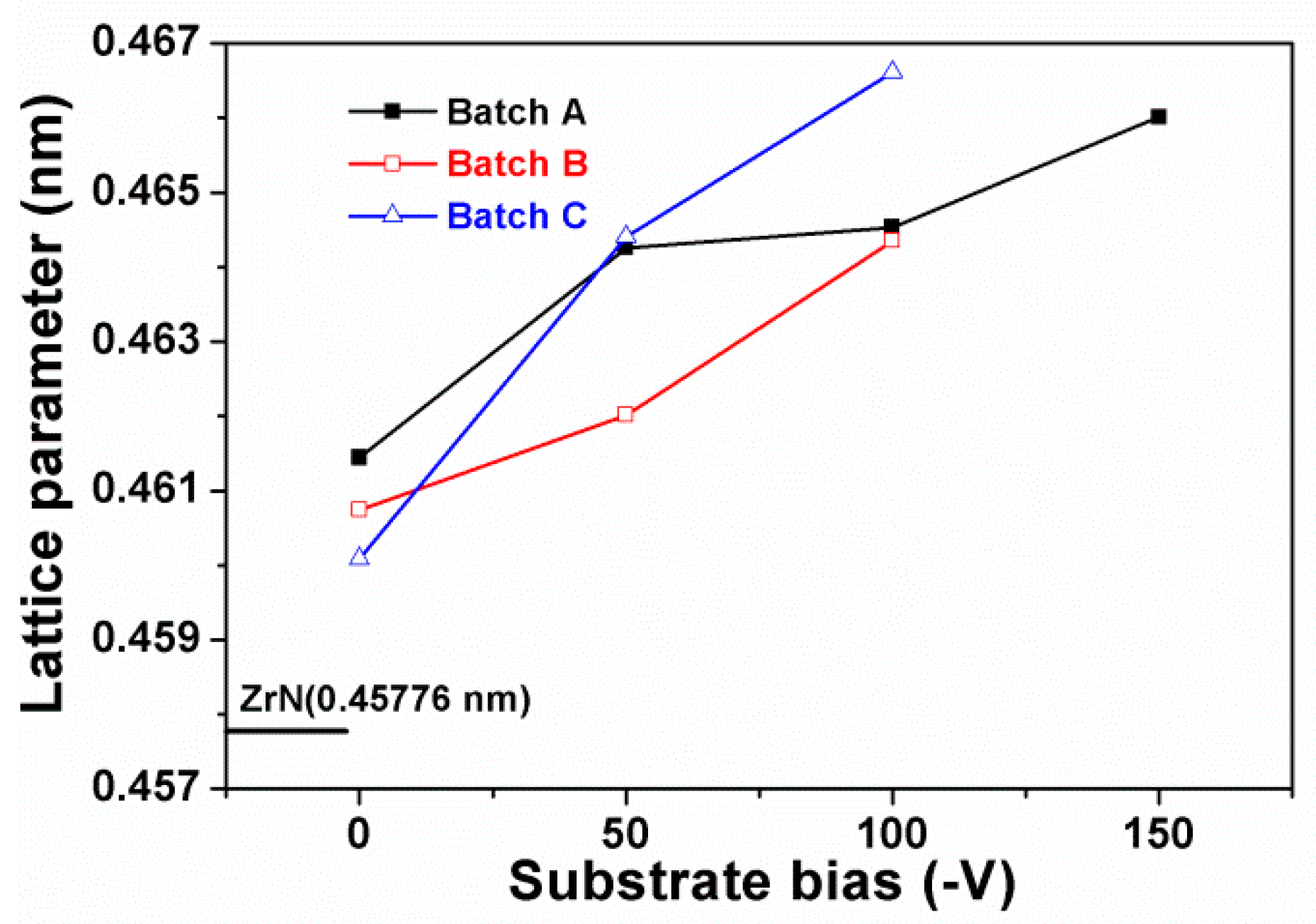

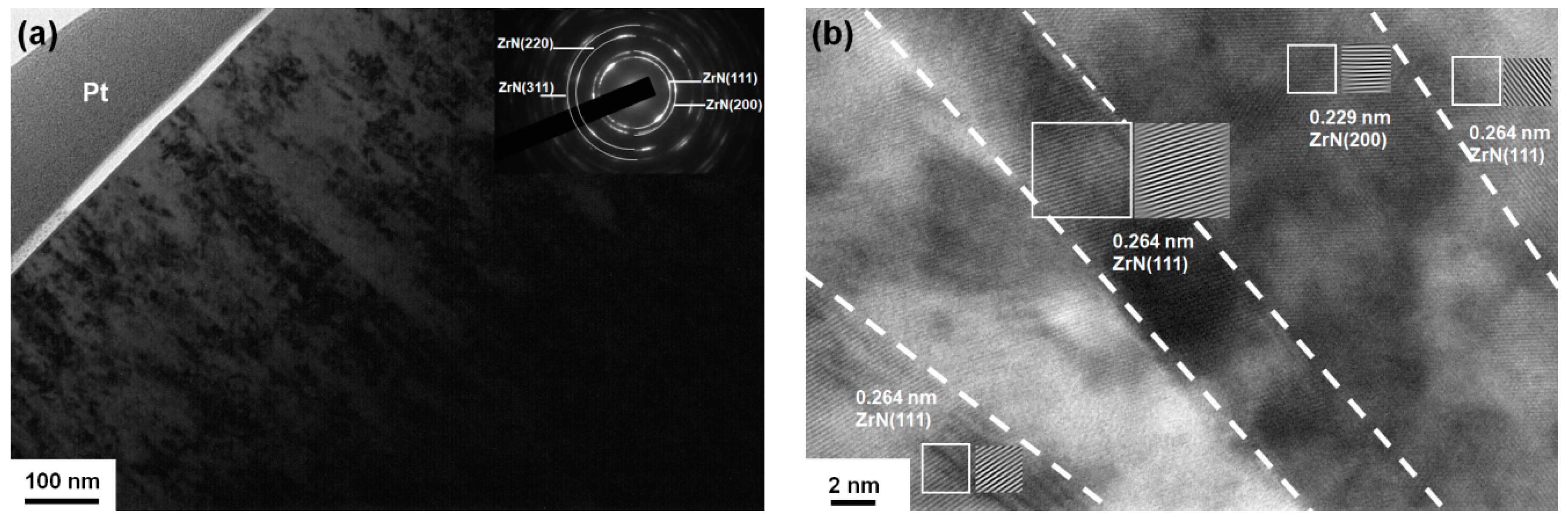
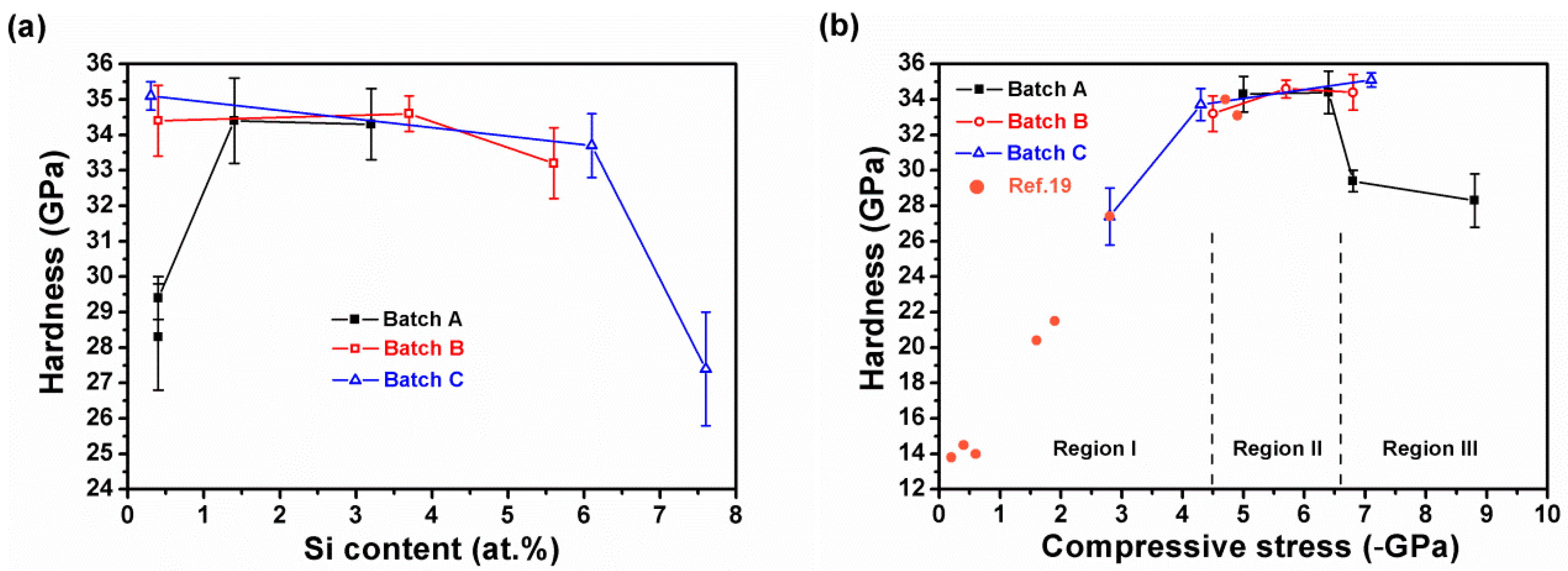

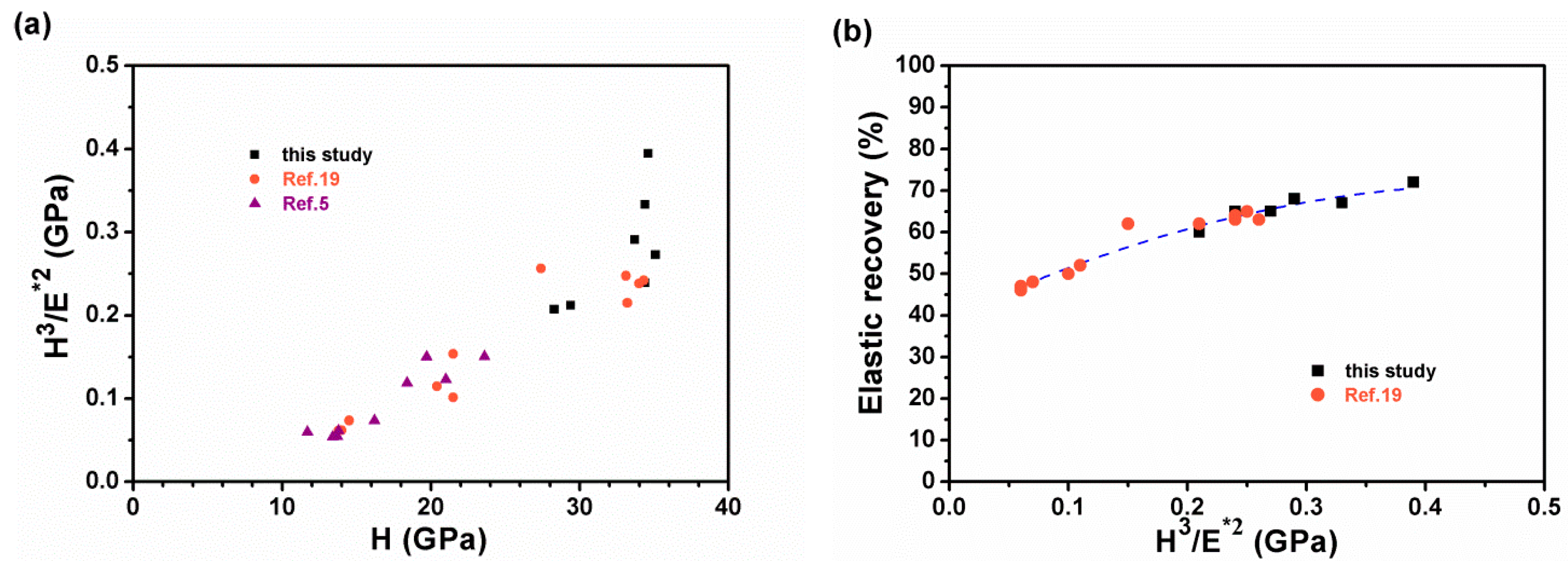
| Sample | Bias | Chemical Composition (at.%) | Time | T 1 | Ra 2 | Stress | |||
|---|---|---|---|---|---|---|---|---|---|
| (−V) | Zr | Si | N | O | (min) | (nm) | (nm) | (GPa) | |
| Batch A, PSi = 30 W | |||||||||
| Zr61.6Si3.2N35.2 | 0 | 61.0 ± 0.4 | 3.2 ± 0.1 | 34.9 ± 0.4 | 0.9 ± 0.2 | 270 | 932 | 1.4 ± 0.1 | −5.0 ± 0.4 |
| Zr62.3Si1.4N36.3 | 50 | 62.2 ± 0.2 | 1.4 ± 0.0 | 36.2 ± 0.4 | 0.2 ± 0.1 | 300 | 1007 | 1.6 ± 0.0 | −6.4 ± 0.6 |
| Zr62.3Si0.4N37.3 | 100 | 62.3 ± 2.1 | 0.4 ± 0.0 | 37.3 ± 2.1 | 0.0 ± 0.0 | 300 | 966 | 1.7 ± 0.1 | −6.8 ± 0.3 |
| Zr62.2Si0.4N37.4 | 150 | 62.2 ± 0.6 | 0.4 ± 0.0 | 37.4 ± 0.7 | 0.0 ± 0.1 | 300 | 959 | 1.2 ± 0.3 | −8.8 ± 0.3 |
| Batch B, PSi = 40 W | |||||||||
| Zr56.2Si5.6N38.2 | 0 | 55.8 ± 0.2 | 5.6 ± 0.1 | 37.9 ± 0.3 | 0.7 ± 0.2 | 230 | 847 | 0.8 ± 0.1 | −4.5 ± 0.6 |
| Zr60.2Si3.8N36.0 | 50 | 58.7 ± 0.9 | 3.7 ± 0.1 | 35.1 ± 0.6 | 2.5 ± 0.2 | 220 | 747 | 0.5 ± 0.0 | −5.7 ± 0.5 |
| Zr58.9Si0.4N40.7 | 100 | 58.0 ± 1.0 | 0.4 ± 0.1 | 40.1 ± 1.0 | 1.5 ± 0.2 | 300 | 1080 | 0.8 ± 0.0 | −6.8 ± 0.5 |
| Batch C, PSi = 50 W | |||||||||
| Zr52.2Si7.6N40.2 | 0 | 52.0 ± 1.1 | 7.6 ± 0.2 | 40.1 ± 1.3 | 0.3 ± 0.1 | 210 | 831 | 3.5 ± 0.1 | −2.8 ± 0.1 |
| Zr57.6Si6.3N36.1 | 50 | 56.3 ± 1.9 | 6.1 ± 0.3 | 35.3 ± 1.8 | 2.3 ± 0.5 | 210 | 747 | 0.3 ± 0.1 | −4.3 ± 0.3 |
| Zr54.8Si0.3N44.9 | 100 | 54.0 ± 2.0 | 0.3 ± 0.0 | 44.3 ± 2.1 | 1.4 ± 0.2 | 265 | 981 | 0.6 ± 0.0 | −7.1 ± 0.3 |
| Sample | Bias | Stress | H1 | E*2 | H/E* | H3/E*2 | We3 |
|---|---|---|---|---|---|---|---|
| (−V) | (GPa) | (GPa) | (GPa) | (GPa) | (%) | ||
| Batch A, PSi = 30 W | |||||||
| Zr61.6Si3.2N35.2 | 0 | −5.0 ± 0.4 | 34.3 ± 1.0 | 408 ± 12 | 0.084 | 0.24 | 64 |
| Zr62.3Si1.4N36.3 | 50 | −6.4 ± 0.6 | 34.4 ± 1.2 | 350 ± 14 | 0.098 | 0.33 | 67 |
| Zr62.3Si0.4N37.3 | 100 | −6.8 ± 0.3 | 29.4 ± 0.6 | 346 ± 10 | 0.085 | 0.21 | 60 |
| Zr62.2Si0.4N37.4 | 150 | −8.8 ± 0.3 | 28.3 ± 1.5 | 331 ± 11 | 0.086 | 0.21 | 60 |
| Batch B, PSi = 40 W | |||||||
| Zr56.2Si5.6N38.2 | 0 | −4.5 ± 0.6 | 33.2 ± 1.0 | 413 ± 13 | 0.080 | 0.21 | 62 |
| Zr60.2Si3.8N36.0 | 50 | −5.7 ± 0.5 | 34.6 ± 0.5 | 324 ± 8 | 0.107 | 0.39 | 72 |
| Zr58.9Si0.4N40.7 | 100 | −6.8 ± 0.5 | 34.4 ± 1.0 | 413 ± 4 | 0.083 | 0.24 | 65 |
| Batch C, PSi = 50 W | |||||||
| Zr52.2Si7.6N40.2 | 0 | −2.8 ± 0.1 | 27.4 ± 1.6 | 283 ± 8 | 0.097 | 0.26 | 63 |
| Zr57.6Si6.3N36.1 | 50 | −4.3 ± 0.3 | 33.7 ± 0.9 | 363 ± 6 | 0.093 | 0.29 | 68 |
| Zr54.8Si0.3N44.9 | 100 | −7.1 ± 0.3 | 35.1 ± 0.4 | 398 ± 6 | 0.088 | 0.27 | 65 |
© 2019 by the authors. Licensee MDPI, Basel, Switzerland. This article is an open access article distributed under the terms and conditions of the Creative Commons Attribution (CC BY) license (http://creativecommons.org/licenses/by/4.0/).
Share and Cite
Chen, Y.-I.; Zheng, Y.-Z.; Chang, L.-C.; Liu, Y.-H. Effect of Bias Voltage on Mechanical Properties of HiPIMS/RFMS Cosputtered Zr–Si–N Films. Materials 2019, 12, 2658. https://doi.org/10.3390/ma12172658
Chen Y-I, Zheng Y-Z, Chang L-C, Liu Y-H. Effect of Bias Voltage on Mechanical Properties of HiPIMS/RFMS Cosputtered Zr–Si–N Films. Materials. 2019; 12(17):2658. https://doi.org/10.3390/ma12172658
Chicago/Turabian StyleChen, Yung-I, Yu-Zhe Zheng, Li-Chun Chang, and Yu-Heng Liu. 2019. "Effect of Bias Voltage on Mechanical Properties of HiPIMS/RFMS Cosputtered Zr–Si–N Films" Materials 12, no. 17: 2658. https://doi.org/10.3390/ma12172658




